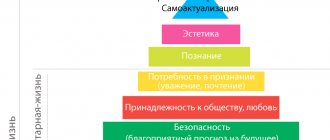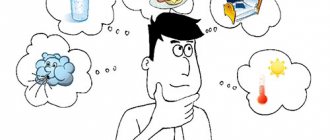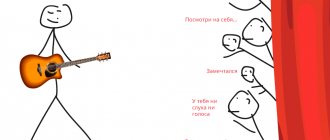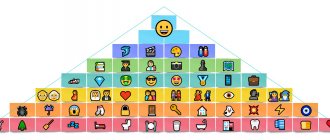Need for cognition
The tendency for cognitive activity is inherent in man by nature. One of the distinctive abilities of man, which sets him apart from the animal world, is the ability to ask questions and seek answers to them. The ability to ask complex, deep questions indicates a developed intellectual personality. Thanks to cognitive activity, an individual improves, develops, and achieves desired goals. In addition to learning about the world around us, a person gets to know himself; this process begins from the first years of life.
Cognition begins with the perception of the surrounding space, into which the baby is immersed from the moment of birth in this world. The baby tastes different objects: toys, his own clothes, everything that comes to hand. Growing up, he begins to comprehend the world through thinking, comparing and contrasting different information, observations, and facts.
The need for knowledge inherent in humans can be explained by the following reasons:
- Presence of consciousness.
- Innate curiosity.
- The pursuit of truth.
- Tendency to creative activity (interrelated with cognition).
- The desire to improve one's own life and the life of the entire society.
- The desire to anticipate and overcome unforeseen difficulties, for example, natural disasters.
Understanding the world around us is a continuous process; it does not stop after graduating from school, university, or retirement. As long as a person is alive, he will strive to comprehend the secrets and laws of the universe, the surrounding space, and himself.
Controversial sides of the pyramid
A logical theory is not as flawless as it seems at first glance.
Abraham Maslow himself emphasized that human motivation is not strictly ordered. In some cases, the steps of the pyramid change places: for example, in case of danger, we forget about severe hunger and strive first to find protection. It is also known that some people have a thirst for recognition that is stronger than the desire for love (this distinguishes careerists).
Further, we do not always step onto the next step, having provided ourselves with sufficient comfort on the previous one. The scientist gives examples of creative people who live from hand to mouth and never give up their favorite pastime, as well as heroes who are ready to die for their beliefs. He notes that the more fully the needs were satisfied in childhood, the easier it is to sacrifice them in the future.
In addition, another psychologist, Clayton Paul Alderfer, argues that moving up the ladder is possible not only from the bottom up, but also back if higher needs are not satisfied.
The categorical classification of sexual instinct as a vital first stage is controversial. The example of great saints and monks (Sergius of Radonezh, Seraphim of Sarov, etc.) proves the opposite.
The pyramid is easy to learn, but not universal. For many people, a different order of steps is applicable, and for others, some of the needs are not characteristic at all due to character, temperament and other characteristics.
Types and ways of knowing
There are many methods and ways of obtaining knowledge about the world around us. Depending on the predominance of a person’s sensory or mental activity, two types of knowledge are distinguished: sensory and rational. Sensory cognition is based on the activity of the senses, rational cognition is based on thinking.
The following forms of cognition are also distinguished:
- Everyday (everyday) . A person gains knowledge based on his life experience. He observes the people around him, situations, phenomena that he encounters every day throughout his life. Based on this experience, a person forms his idea of the world and society; it is not always true, and is often erroneous.
Example. Marya Ivanovna, a high school mathematics teacher, believes that all students cheat. She formed this opinion thanks to her rich life experience, having worked at school for more than 10 years. But, in reality, her conclusions are erroneous and exaggerated, because there are guys who complete all the tasks on their own.
- Scientific knowledge . It is carried out in the process of a targeted search for objective knowledge that can be proven in theory and in practice. Methods of scientific knowledge: comparison, observation, experiment, generalization, analysis. The results of scientific knowledge are theorems, hypotheses, scientific facts, discoveries, and theories. If you open any school textbook, most of the information contained in it is the result of long-term scientific knowledge.
- Religious knowledge is belief in divine and demonic forces: God, angels, the Devil, devils, the existence of heaven and hell. It can be based on belief in one single God, or many Gods. Religious knowledge also includes beliefs in mystical powers and the supernatural.
- Artistic knowledge is the perception of the world based on ideas about beauty. Cognition is carried out through artistic images and means of art.
- Social cognition is a continuous process of acquiring knowledge about society as a whole, individual social groups, and people in society.
- Philosophical knowledge is based on interest in the search for truth, comprehension of man’s place in the surrounding world, the universe. Philosophical knowledge is discussed when the questions are asked: “Who am I,” “For what purpose was I born,” “What is the meaning of life,” “What place do I occupy in the universe,” “Why is a person born, sick, and dead?”
Sensory cognition
Sensory cognition is the first type of cognitive activity available to humans. It is carried out through the perception of the world based on the activity of the senses.
- With the help of vision, an individual perceives visual images, shapes, and distinguishes colors.
- Through touch, he perceives the surrounding space by touch.
- Thanks to the sense of smell, a person can distinguish more than 10,000 different odors.
- Hearing is one of the main senses in the process of cognition; with its help, not only sounds from the surrounding world are perceived, but also knowledge is disseminated.
- Special receptors located on the tongue allow a person to feel 4 basic tastes: bitter, sour, sweet, salty.
Thus, thanks to the activity of all senses, a holistic idea of an object, an object, a living being, or a phenomenon is formed. Sensory cognition is available to all living beings, but has a number of disadvantages:
- The activity of the senses is limited, especially in humans. For example, a dog has a stronger sense of smell, an eagle has vision, an elephant has hearing, and an echidna has a stronger sense of touch.
- Often sensory knowledge excludes logic.
- Based on the activity of the senses, the individual is drawn into emotions: beautiful images cause admiration, an unpleasant smell causes disgust, a sharp sound causes fear.
According to the degree of knowledge of the surrounding space, it is customary to distinguish the following types of sensory knowledge:
- 1st view - sensation . It represents a separate characteristic of an object, obtained through the activity of one of the sense organs.
Example. Nastya smelled hot bread while walking down the street; it was brought by the wind from the bakery where bread was being baked. Petya saw a shelf with oranges in the store window, but he did not have money with him to go in and buy them.
- 2nd type - perception . This is a set of sensations that creates a holistic picture, a general image of an object or phenomenon.
Example. Nastya was attracted by the delicious smell, went into the bakery and bought bread there. It was still hot, with a crispy crust, and Nastya ate half of it at once during lunch. Petya asked his mother to buy oranges at home, in the store opposite the house. They were large and bright in color, but they tasted sour and disgusting. Petya could not finish even one piece of fruit.
- 3rd view – presentation . This is the memory of an object, a subject explored earlier, thanks to the activity of the senses.
Example. Feeling the familiar smell of bread, Nastya immediately wanted to have lunch; she well remembered the crispy crust of a fresh hot loaf. Petya, having attended a friend’s name day, grimaced at the sight of oranges on the table; he immediately remembered the sour taste of the recently eaten fruit.
Material and spiritual needs
Material needs are the needs of a person to ensure his material existence. They are divided into material-biological and material-social. Material-biological needs include food, clothing, and housing needs. In modern service there are many industries and areas that serve each of these needs. Thus, the catering system and restaurant service are responsible for satisfying food needs; clothing needs - sewing workshops, shops, laundries, etc.
Material and social needs include labor, communication - interaction in the process of labor activity and the exchange of labor products (Fig. 3.2).
Rice. 3.2. Systematization of material needs
Spiritual needs are the needs for knowledge, moods, experiences and impressions. Spiritual needs include the needs for knowledge, education, upbringing and the meaning of life (Fig. 3.3).
Rice. 3.3. Systematization of spiritual needs
The need for knowledge is a person’s desire to know objective phenomena, properties and patterns of reality. It is generated by material needs for successful work activity, which cannot exist and improve without the accumulation of knowledge about the world.
Back in 1947, R. Woodworth drew attention to a need that had been ignored until then, namely, the “desire to perceive.” He noted that our relationship with the environment is characterized not only by our inherent motive to see and hear, but “to see clearly, to hear clearly, to understand what a person sees or hears at every moment of time.”
The most developed forms of knowledge are scientific and artistic.
Scientific knowledge is aimed at revealing the objective laws of nature and society, explaining and predicting changes in the phenomena being studied. It includes verifiable and verifiable facts of generalization,
In scientific knowledge, two methods can be distinguished: analysis and synthesis. Analysis is a real, mental division of an object into its component parts (sides, characteristics, properties) for the purpose of their comprehensive consideration and study. Synthesis is closely related to analysis—the combination of previously identified parts (features, sides, relationships) of an object into a single whole; this is the other side of analysis.
Analysis and synthesis are the simplest, elementary methods of cognition that lie at the very basis of human thinking (analytical-synthetic activity). At the same time, they are universal methods of logical, cognitive activity - they organically enter into any scientific research and form its first stage, when “the researcher moves from an undifferentiated description of the object being studied to identifying its structure, composition, as well as its properties and characteristics.”
There are several types of analysis and a variety of forms of synthesis. Analysis as a mental (and in an experiment, real) division of a whole into parts. This type of analysis involves not only fixing the parts, but also establishing relationships between them. In this case, the analyzed object is often considered as a representative of a certain class of objects, which makes it possible to transfer the knowledge obtained from the study of some objects to others.
“Another type of analysis is the analysis of the general properties of objects and the relationships between them, when a property and a relationship are divided into component properties or relationships.” In this case, this procedure allows us to reduce the concepts of the most general properties and relationships to simpler concepts and properties. In science, there is also such a type of analysis as dividing many classes into subclasses, in other words, classification.
Synthesis appears either in the form of a relationship between theories related to one subject area, or as a unification of competing theories. Modern science is a synthesis not only within individual scientific disciplines, but also between different disciplines (for example, synthesis led to the formation of such disciplines as biophysics, biochemistry, econometrics, etc.). Today, there is a process of integration of scientific knowledge, which has led to the emergence of cybernetics, semiotics, and systems theory, which synthesize knowledge about the structural properties of objects from different disciplines.
It is worth highlighting such techniques of scientific knowledge as abstraction, generalization, induction and deduction.
Abstraction is a special method of thinking, which consists in the ability to abstract from specific properties and relationships of the phenomenon being studied while simultaneously highlighting the properties and relationships that interest the researcher. The result of abstraction is “abstract objects”, which are either individual categories, concepts (“tree”, “number”, “vegetables”), or a system of concepts.
Abstraction involves the replacement of properties, qualities and relationships with special signs and concepts, which are fixed in the mind in the form of abstractions. For example, the properties and qualities of spruce, pine, birch, etc. are replaced by one general concept “tree”, which is an abstraction from specific properties and qualities and at the same time captures the general thing that characterizes each of them. This creates the basis for combining them into a single class.
Generalization is a thinking technique as a result of which the general characteristics and properties of objects are established.
The generalization procedure is carried out in stages, from individual, special properties and qualities reflected in the concept to more complex abstractions. Thus, animals whose main means of maintaining life is eating plant foods are united into a single species, genus, by the concept of “herbivores”. More general in relation to this concept is the abstraction “animals”, even more general - “fauna”, etc.
The process of cognition and research is carried out using such a technique when, on the basis of existing knowledge, it is possible to draw conclusions about what is unknown, arriving at the discovery of general principles. Sometimes, on the contrary, using general principles, they make conclusions about particular phenomena. Such techniques in scientific activity are defined as “induction” and “deduction”.
Induction is a type of generalization associated with anticipating the results of observations and experiments. The basis of induction is experience, therefore inductive generalizations are considered as experimental truths or empirical laws. Induction is a method of reasoning when, on the basis of facts and their analysis, common, repeating features of a number of phenomena included in a certain class are identified.
On their basis, an inference is built based on judgments about individual facts and phenomena. A judgment is a conclusion in which some attribute is attributed to the entire class. For example, by studying the properties of water, alcohols, and liquid oils, it is established that they all have the property of elasticity. Since they are all liquids, they come to the conclusion that all liquids are elastic.
However, experience is infinite and incomplete , and therefore the conclusions of induction are often problematic, probabilistic in nature, and therefore it is unacceptable to talk about the truth of inductive generalizations or their logical validity. Induction represents only a source of conjectural judgments-hypotheses, which must then be tested or justified by more reliable techniques and principles.
Deduction - based on existing general knowledge, conclusions of a particular nature and nature are drawn. Often the basis, the starting point of deduction is inductive reasoning, thus deduction complements induction, expanding the scope of general knowledge. But the value of deduction is not so much that it complements induction, but that it is capable of reaching generalizations, starting from hypotheses and ideas. In this case, it is the starting point for the emergence of new theories.
The term “deduction” is used in two meanings: as a synonym for the word “inference” and as a generic designation for the general theory of constructing correct conclusions. There is a whole class of sciences that are commonly called deductive, since their conclusions are based on general initial principles, postulates, and axioms. These include mathematics, theoretical mechanics, some branches of physics, etc.
A characteristic feature of deduction is that new truths are derived from existing knowledge, without recourse to experience, intuition or common sense. This allowed the modern scientist-philosopher Francis Bacon (16th century) to declare that deduction is a “minor method,” while true knowledge is provided only by induction, since it is based on experience. R. Descartes contrasted deduction with intuition, through which, in his opinion, the human mind “directly perceives the truth,” while deduction provides the mind with only “indirect” (obtained through reasoning) knowledge. Subsequently, scientists Leibniz and Wolf came out in defense of deduction, considering deductive knowledge to be “true in all possible worlds.”
A dialectical approach, which considers the significance of both methods of cognitive and mental activity in unity, complementarity and interaction, helps to resolve the dispute about the preference This approach is clearly expressed in the following position of scientists of the late 19th - early 20th centuries: “Great discoveries, leaps of scientific thought forward are created by induction, a risky, but truly creative method... From this,” one should not conclude that the rigor of deductive reasoning is not has no value. In fact, only it prevents the imagination from falling into error; only it allows, after establishing new starting points by induction, to draw consequences and compare conclusions with facts. Deduction alone can provide a test of hypotheses and serve as a valuable antidote to overextended imagination.”
Artistic cognition is a special aesthetic development of reality in an artistic and figurative form. Artistic knowledge differs from scientific knowledge in that science, as a rule, strives for the most impersonal knowledge, while art is focused on the unique personality of the creator, on his subjective vision of the world, which most often constitutes the main interest in a work of art. In contrast to the figurative and emotional nature of artistic creativity, science is characterized by intellectualism and rationalism.
Art is usually called a specific form of social consciousness and human activity, which is a reflection of the surrounding reality in artistic images. Through the creation of works of art, such a type of cognitive activity of people as artistic cognition is realized. Art represents the highest form of aesthetic consciousness. It is a necessary element of social consciousness, ensuring its integrity, mobility, stability in the present and direction towards the future.
The form of existence of art is a work of art that has specificity and genre definition and is realized as a material object - a sign that conveys to people a certain artistic concept that has aesthetic value.
Art as a cultural phenomenon is divided into a number of types, each of which has a specific language and its own sign system. Scientists distinguish the following types of arts.
Architecture (architecture) is a type of art that is a system of buildings and structures that form the spatial environment for human life.
Architecture occupies a special place among other arts because it does not depict objects, but creates them. Architecture can be public, residential, urban planning, gardening, industrial, restoration.
Painting is a type of art whose works are a reflection of life on a certain surface using color. The following genres are distinguished in painting:
- portrait - an image of a person or group of people who exist or existed in reality;
- still life - an image of things surrounding a person;
- landscape - an image of natural or man-transformed nature;
- everyday genre - depiction of people's everyday life;
— animalistic genre — depiction of animals;
- historical genre - depiction of historical events and figures.
Sculpture is a type of fine art, the works of which have a physically material, objective volume and a three-dimensional form located in real space. Sculpture is divided into round (head, bust, torso, statue) and relief. A relief is a convex image on a stone. All reliefs are divided into bas-reliefs, high reliefs and counter-reliefs. Bas-relief is a low relief that rises above the plane by less than half of its actual volume. High relief is a high relief that rises above the plane by more than half of its actual volume. Counter-relief is an in-depth relief.
Decorative and applied art is a type of fine art directly related to the everyday needs of people. Decorative and applied arts include works made from a variety of materials (traditionally wood, clay, stone, glass and metal). The peculiarity of this type of art is its utilitarianism and inclusion in people’s everyday lives. Like architecture, decorative and applied art is a constantly operating factor in the formation of the human environment.
Literature is a type of art that reflects reality in verbal and written images. The first literary works - legends, epics, myths - appeared even when humanity did not have writing, and were passed on from mouth to mouth. Oral folk art is usually called folklore .
Music is an art form that reflects reality in sound artistic images. Music intended for singing is called vocal. If a piece is performed only on instruments, then such music is called instrumental.
Theater is an art form, the specific means of expression of which is stage action that occurs during the actor’s performance in front of the public.
Circus is the art of acrobatics, balancing act, gymnastics, pantomime, juggling, magic tricks, clowning, musical eccentricity, horse riding, animal training.
Ballet is an art form whose content is revealed in dance and musical images.
Cinema is an art form whose works are created by filming real events, specially staged or recreated by means of animation.
Photographic art is the art of creating, using chemical and technical means, a visual image of documentary significance, artistically expressive and authentically capturing an essential moment of reality in a frozen image.
Variety is an art form that includes small forms of drama, music and choreography, the main works of which are individual completed numbers.
The specificity of art as a form of artistic knowledge lies in the fact that, firstly, it is figurative and visual. The subject of art - people's lives - is extremely diverse and is reflected in art in all its diversity in the form of artistic images. The latter, being the result of fiction, are nevertheless a reflection of reality and always bear the imprint of really existing objects, events and phenomena.
An artistic image performs the same functions in art as a concept in science: with its help, the process of artistic generalization occurs, highlighting the essential features of cognizable objects. The created images constitute the cultural heritage of society and are capable, having become symbols of their time, to have a serious influence on public consciousness.
Secondly , artistic cognition is characterized by specific ways of reproducing the surrounding reality, as well as the means by which artistic images are created. In literature, such a means is the word, in painting - color, in music - sound, in sculpture - volumetric-spatial forms, etc.
Thirdly , the imagination and fantasy of the learning subject play a huge role in the process of understanding the world through art. Artistic invention, which is allowed in art, is completely unacceptable, for example, in the process of scientific knowledge.
Unlike various social sciences that study individual aspects of people's lives, art studies the person as a whole and, along with other types of cognitive activity, is a special form of knowledge of the surrounding reality.
Art is included in an integral system of forms of social consciousness, which, along with it, includes the philosophy, politics, law, science, morality, and religion already discussed above. All of them realize their functions in a single cultural context that arises due to their interrelations.
Education is the process of acquiring systematized knowledge, skills and abilities. It is one of the main human needs, as it has become a necessary condition for preparing for work and communication. The need for education is essentially a specification and a more developed form of the need for cognition. In modern society, a person does not need some vague set of knowledge, but a high-quality education system and reliable criteria for this quality.
Educational needs are characterized by multi-level functional diversity. At the personal level, the need for education performs the functions of enriching the individual with new knowledge necessary for various types of activities, socialization, individualization, self-determination, self-realization, professional and status growth, the implementation of lifelong education, changing the structure of the personality, the formation of its educational interests, goals, value orientations, motives, attitudes towards educational activities, shaping the individual’s lifestyle, stimulating the individual’s work activity, the effectiveness of work, adapting the individual to the social environment through the acquisition of knowledge, information, etc.
At the group level, the need for education realizes the functions of social development of groups, social communities, the whole society, increasing the educational level of the individual, individual social groups and society as a whole, institutionalizing lifelong education, forming a subculture of a social group, community, forming the intellectual culture of social groups and society, self-identification of social groups, reproduction of social groups and the institution of profession, changes in the nature of social labor, increasing its efficiency, regulation of social mobility processes, adaptation of social groups and communities to changes in social conditions in society, etc.
Education is a purposeful influence on a person to prepare him to perform the whole variety of social functions (work, communication, cognition). It is part of the socialization process and is a need, since without the targeted influence of adults, a child will not be able to become a capable member of society.
Education in the broadest sense of the word is the process and result of human development, which does not stop throughout his life. The essence of education is the transfer, assimilation and acquisition by a person of the experience of life in society and in the conditions of a specific culture (subcultures), creating conditions for the emergence and development of internal motivation. Hence the emphasis in education on the tasks of a person developing a system of personal meanings in the process of self-actualization and self-determination.
“ Good manners ” - “bad manners” act as one of the main attributes of human individuality, characterizing both an adult and a child in various typological situations of interpersonal interaction, in their ability and desire to adequately assess situations and themselves in these situations, in the choice of action strategies, implying approval in a certain culture (subculture) and/or not leading to “internal” discord and negative assessments.
The need for meaning in life is the most complex spiritual need. It is expressed in the formation of a worldview - a person’s system of views on the world as a whole and his place in this world.
The search for the purpose of life is based on the idea of the value of human life, and the value not only for the person himself, but also for society, for other people. Each person has his own ideas about the meaning of life. But in these individual ideas there is inevitably a general element, determined by the goals and interests of the society to which the person belongs. The question of the meaning of human life is a key ideological problem. The direction of his social activity depends on its decision. It is no coincidence that religion and idealism have fought against materialism since ancient times precisely on issues of the meaning of life. Correctly determining the meaning of your life means finding yourself.
The meaning and purpose of human life is to change the world around us in order to satisfy its needs, this is undeniable. But by changing external nature, a person also changes his own nature, that is, he changes and develops himself. Exploring the processes of personality development, we consider a number of levels of analysis of the meaning of life (“purpose”) of a person: development as the meaning of life, comprehensive development as the meaning of life of a new type of personality, self-realization of a person as an active fulfillment, the fulfillment of his purpose.
The meaning of life is the most flexible characteristic of both material and spiritual needs. Ultimately, the system of needs itself is determined by the meaning of life: if this is the increase in personal wealth, then, naturally, this leads to an exaggerated development of material needs. And vice versa, spiritual development, which has become the goal of life, dominates the structure of the personality in the form of corresponding spiritual needs. The meaning of life is determined, first of all, by specific historical conditions, interests and needs. Ultimately, the meaning of life is determined by an objectively existing system of social relations.
In real life, material and spiritual needs, as well as techniques and methods for satisfying them, interact and intertwine.
Thus, satisfying material needs always requires some level of knowledge, i.e., spiritual prerequisites.
To satisfy any spiritual needs, material objects are used - such as books, paints, canvas and other equipment. Therefore, the satisfaction of spiritual needs becomes possible through the satisfaction of the material ones accompanying them.
Rational cognition
Rational knowledge is knowledge based on logical thinking. It differs from the sensory in important characteristics:
- Availability of evidence. If the result of sensory cognition are sensations obtained from one’s own experience, then the result of rational cognition are facts that can be proven using scientific methods.
- The systematic nature of the knowledge gained . Knowledge is not isolated from each other, it is interconnected into a system of concepts and theories, forming separate sciences.
Example. History is a science based on rational knowledge. All knowledge obtained with its help is systematized and complements each other.
- The presence of a conceptual apparatus . Thanks to rational knowledge, concepts and definitions are created that can be used in the future.
Methods of rational cognition are:
- logical method (the use of logical thinking in knowing something);
- synthesis (connection of individual parts, data into a single whole);
- observation;
- measurement;
- comparison (determining differences, similarities);
All existing sciences and teachings were created on the basis of rational knowledge.
HOW TO UNDERSTAND YOURSELF
Understanding yourself = understanding your needs.
Needs are built-in programs for maintaining internal balance: mental and physiological.
It often turns out that we do not know how to listen to ourselves. The cure is to have moments of clarity and answer questions.
FOUR STEPS TO UNDERSTANDING:
1. answer questions and understand needs;
2. accept everything - even if they contradict each other;
3. sit and consider options for the development of events without haste;
4. voice to yourself or another person what you want and will do “here and now”: without shifting responsibility, specifically.
I go through these four steps when I finish something or when I don't know what I want.
Literally: I felt that I was distracted from work - I sat down in another place, opened a form on my phone, and listened to myself. Once again clarifying how we are doing ourselves is normal and human.
Fragment of the book “Easy and simple. How to cope with tasks that are scary to approach.” Timur Zarudny / Sergei Zhdanov. - Moscow: Bombora Publishing House, 2022.
Ways to find information
In modern times, information search has become one of the ways to understand the world around us. A wide variety of media greatly increases a person’s cognitive capabilities. Thus, cognition is carried out through:
- printed publications (newspapers, books, magazines);
- Internet;
- television;
- radio broadcasting;
Using the Internet you can very quickly and easily find almost any information, but it is not always reliable. Therefore, when choosing ways to search for information, you need to be careful and check data in different sources.
Example. In 2012, many articles were published on the Internet that foreshadowed the end of the world. Some talked about an asteroid falling to Earth, others about global warming and flooding of the land surface. But this could be easily verified by finding research by different scientists about upcoming natural disasters and comparing their results with each other.
The importance of the theory of needs for personality
However, Maslow's theories can be successfully applied in life.
It allows a person:
- understand yourself, find out unconscious needs, understand the degree of dissatisfaction with something (for example, the method of constellations is aimed at this);
- set priorities and organize life in accordance with them;
- choose the desired and appropriate direction of activity (cognitive, social, professional);
- understand the desires of loved ones (spouse, child), guide them in the right direction (in raising children).
Self-knowledge
From an early age, a person observes his appearance, evaluates his activities, and compares himself with others. Every year he learns something new about himself: abilities, character traits, and personality traits manifest themselves. Self-knowledge of a person is not a quick, gradual process. By recognizing one's strengths and weaknesses, a person can improve and develop.
Self-knowledge consists of several levels:
- Self-recognition. At the age of 1-1.5 years, the child begins to recognize himself in the mirror and understand that his reflection is there.
- Introspection. The individual observes his actions, thoughts, and actions.
- Introspection. A person is aware of his character qualities, characteristics, evaluates them, and compares them with moral standards. He compares his actions and the results to which they led.
- Self-esteem. A person develops a stable idea of himself as an individual. Self-esteem can be objective, suspended or underestimated.
In addition, self-knowledge can be directed by a person to his own mental, creative or physical abilities. A separate type is spiritual self-knowledge, in this case a person is interested in the nature of his soul.
SOUND → DO
Two rules help you voice your needs.
The first thing is not to complain or shift responsibility to someone else. To do this, it is important to allow your experiences without complaints.
WITH CLAIM
I'm such a fool that I can't concentrate. Why can't I pull myself together and change something in my life?
ABOUT ME
I'm tired, I'm bored. I'm bored sitting at home and want to be active. I'll go to the skating rink.
When you scold yourself or shift responsibility for your well-being to circumstances or to other people in general, you are overstepping the boundaries and area of your responsibility. Unfortunately, it doesn’t work like that: it’s all aggression and violence - towards yourself or others.
The second rule is to formulate the need clearly, specifically and for implementation here and now. Without this, it is unclear what to do, and the other person may even perceive it as a threat.
ABSTRACT
I'm tired and don't want to work. I want us to spend more time together.
SPECIFICALLY
I’m tired: I’ll go to the cinema for an afternoon session, and then I’ll see what I do. Sit with me for 10 minutes.
This is all to the principle “we lack clarity, not motivation.”
The rich inner world of man
The inner world of a person is his desires, goals, beliefs, worldview, ideas about himself and other people, values. You can notice your appearance immediately and appreciate its attractiveness, but with the inner world things are more complicated. At first glance it is invisible, but over time it manifests itself in a person’s communication and actions.
It often happens that an outwardly unattractive person still evokes sympathy due to his inner qualities. Conversely, a beautiful person quickly causes disappointment if he behaves stupidly, impudently, and selfishly. So the inner world and appearance, actions - form a single whole, making up a general idea of \u200b\u200ba person.
REALIZE
First we need to learn to recognize what we need. Without this, there will only be continuous habits, automatisms and self-abuse. So far I have not come up with anything better answers to the questions:
- what am I feeling now?
- Why do I do what I do?
- What do I need now from my needs?
- what do I want?
As soon as I catch myself thinking that something is wrong and nothing makes me happy, I stop working, move to another place and open a Google form with prepared questions. Something wrong:
- I get distracted by social media;
- I get irritated;
- I'm bored and don't know what to do;
- I get stuck in pictures or not very interesting articles;
- I replay in my head a conversation with my wife or friend;
- I want something, but I don’t know what.
This all sounds a lot like fatigue. Previously, I tried to get rid of irritants and return to business by force of will, but I realized that this does not work: the energy is spinning, nothing is cloudy. When I understood the principle of operation of the prefrontal cortex and realized that it needed rest, things went well, but I still didn’t go well with identifying needs. Therefore, the rule now works: in any incomprehensible situation, answer the prepared questions.
ON AUTOMATIC
I’m working, I feel like my concentration has gone, I’m constantly distracted. It's noon - there's still a lot of work time, you need to tighten up and return your attention to work. I don’t understand what to do, my mood is spoiled.
CONSCIOUSLY
I understand that I am distracted, I move to another place and answer questions. I stop doing what I was doing and open up questions.
We have already talked about the benefits of recording emotions, but I will repeat it. Writing helps me get out of the context of thoughts in which I am immersed right now and redirect my attention. When you concentrate on describing feelings, the focus shifts, and the brain hamster moves away from the circular distance. This allows you to look at yourself from the outside even in conflict situations.
The main thing is to switch and start responding. Subsequently, you don’t have to re-read the entries, although sometimes it is interesting to remember how I reacted to certain things five years ago.
Last year I fell in love with Google Forms because they were free and easy. Answering using a ready-made form is easier than remembering or looking for questions - the likelihood of forgetting due to laziness is reduced. Open it - write, it’s simple. But laziness still regularly strikes. It’s physically difficult to explain to myself that this is useful, so I try to concentrate on the feeling of relief and clarity that comes as I answer. The more victories you have, the easier it becomes over time.
It still bothers me a little that I look like an idiot who cannot control his own desires and every time he gets tired, like a robot, he goes to answer questions. But this is because I am still unconscious and stupid.











